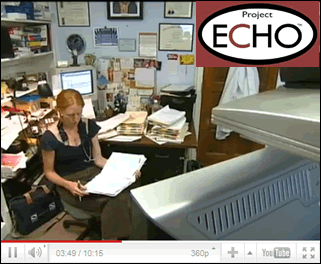Primary Care Docs Can Manage Hepatitis C Treatment
- Details
- Category: HCV Treatment
- Published on Tuesday, 05 July 2011 13:07
- Written by Liz Highleyman
The ECHO program showed that primary care clinicians can successfully treat underserved hepatitis C patients using video teleconferencing.
The burden of disease due to chronic hepatitis C virus (HCV) infections is growing in the U.S. as people infected years or decades ago reach the stage of advanced liver disease. In addition, many people who were waiting for better therapies are now coming forward to seek care since the approval of 2 new direct-acting antivirals -- boceprevir (Incivek) and telaprevir (Incivek) -- which can shorten treatment duration and improve chances of achieving a cure.
But some experts warn of a shortage of specialists for all these potential patients, as many primary care providers lack the training and experience to manage the complexities of today's combination therapy, including side effects and risk of resistance if new drugs are not used appropriately.
As described in the June 9, 2011, New England Journal of Medicine, the Extension for Community Healthcare Outcomes, or ECHO, program was developed to improve access to care for underserved populations. ECHO uses video-conferencing technology to train primary care providers to treat complex diseases such as hepatitis C.
ECHO Video-Conferencing Technology

To evaluate this program, Sanjeev Arora and colleagues conducted a prospective cohort study to compare hepatitis C treatment at the University of New Mexico HCV clinic and treatment by primary care clinicians at 21 ECHO sites in rural areas and prisons in New Mexico.
At the time of the analysis there were 16 community sites and 5 prisons using the ECHO model to deliver hepatitis C treatment, and more than 800 patients have been managed since the program's inception in 2003, the study authors noted as background.
The study enrolled 407 previously untreated chronic hepatitis C patients: 146 at the university and 261 at the ECHO sites. Just under half the people seen at the university were Hispanic/Latino or other "minorities," compared with approximately two-thirds at the rural community sites and prisons.
The primary study endpoint was sustained virologic response (SVR), or continued undetectable HCV viral load 6 months after completion of treatment -- generally considered to be a cure.
Results
"The results of this study show that the ECHO model is an effective way to treat HCV infection in underserved communities," the study authors concluded. "Implementation of this model would allow other states and nations to treat a greater number of patients infected with HCV than they are currently able to treat."
"ECHO represents a needed change from the conventional approaches in which specialized care and expertise are available only at academic medical centers in urban areas," they added. "The ECHO model has the potential for being replicated elsewhere in the United States and abroad, with community providers and academic specialists collaborating to respond to an increasingly diverse range of chronic health issues."
Department of Internal Medicine and Clinical and Translational Science Center, University of New Mexico, Albuquerque, NM; Presbyterian Healthcare Services, Adult and Geriatric Behavioral Health Clinic, Albuquerque, NM; Department of Internal Medicine, University of Iowa, Iowa City, IA.
7/5/11
References
S Arora, K Thornton, G Murata, et al. Outcomes of treatment for hepatitis C virus infection by primary care providers. New England Journal of Medicine 364(23):2199-2207(abstract). June 9, 2011.
 Primary Care Docs Can Manage Hepatitis C Treatment
Primary Care Docs Can Manage Hepatitis C Treatment





























